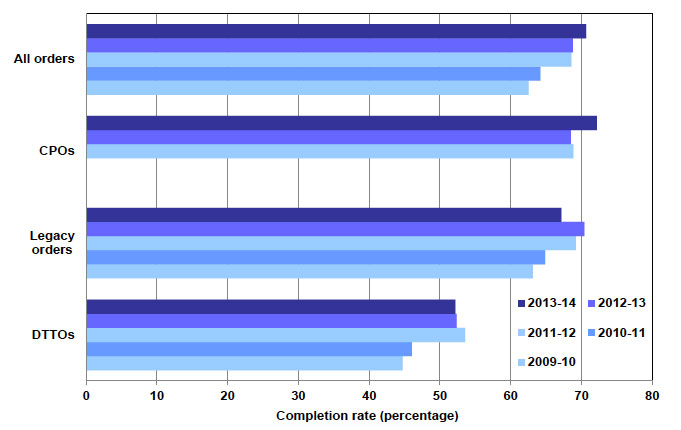Criminal justice social work statistics in Scotland: 2013-14
An annual publication of statistics on community payback and other social work orders, including breaches and terminations of orders, as well as criminal justice social work (CJSW) reports and other areas of CJSW.
This document is part of a collection
5.1 Trends in social work orders
5.1.1 Social work orders include community payback, community service, probation, supervised attendance and drug treatment and testing orders. Community payback orders replaced community service, probation and supervised attendance orders for offences committed on or after 1 February 2011, and these latter three orders are referred to as 'legacy' orders in this report.
5.1.2 The most recent figures show an increase of 4 per cent in the number of social work order commencements between 2012-13 and 2013-14. Overall, the trend has been relatively stable over the past five years, with numbers generally around the 20,000 mark (Table 1). Local authority and community justice authority level breakdowns are available in the additional datasets which accompany this publication.
5.1.3 The vast majority (91 per cent) of social work orders were community payback orders, with 18,600 commencements in 2013-14 (Table 1).
5.1.4 Seventy eight per cent (around 16,000) of orders commencing in 2013-14 included an element of unpaid work or other activity (Table 1 and Table 10). This was about the same level as in 2012-13, but substantially higher than in 2010-11 (68 per cent).
5.1.5 The number of terminations (including completion/discharge, revocation and other reasons for termination) of social work orders rose in 2013-14, for the second year in a row, to 19,200, the highest level in any of the last seven years (Table 1).
5.1.6 Seventy one per cent of social work terminations in 2013-14 (13,600) resulted in completion or discharge (Table 1 and Chart 3). This proportion has increased every year since 2008-09, when it sat at 59 per cent. Completion rates vary between the different types of order, with the higher tariff drug treatment and testing order showing lower completion rates, reflecting the challenges facing this particular client group.
5.1.7 The completion rates for legacy orders issued during the past couple of years are not strictly comparable with earlier years as the former will not include cases involving crimes committed after the introduction of the community payback order. Legacy orders issued from 2011-12 onward are therefore likely to involve more complicated court cases compared to cases resulting in a community payback order, and meaningful comparison of completion rates between the two groups is not straightforward.
Chart 3 Completions of social work orders: 2009-10 to 2013-14

Note: Any comparison between completion rates for different orders since 2011-12 should be interpreted with caution as the legacy orders will tend to involve a different offender mix than the group currently getting a community payback order. Comparing completion rates for legacy orders before and after the introduction of the community payback order is therefore also problematic as recent cases may involve more complicated and longer court cases compared to cases resulting in a community payback order.
Contact
Email: Alan Fleming
There is a problem
Thanks for your feedback